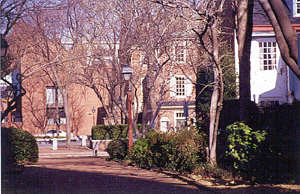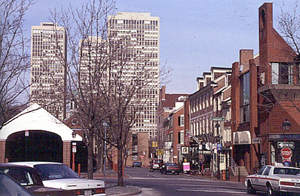
By the 1940s, Society Hill had gained a reputation as one of the worst slums in Philadelphia. The historic, once-thriving neighborhood was overwhelmed by a chaotic mixture: poorly maintained rooming houses and other deteriorated or vacant residential properties; a massive, overcrowded food distribution center; and dilapidated commercial buildings, scattered throughout the area.
During the 1950s, when the federal government began to make a substantial commitment to altering the nearby Independence Hall area, the City of Philadelphia drafted a reinvestment plan for Society Hill. After a survey of the neighborhood's assets, the City decided that Society Hill property owners should be required to restore their historic-house facades to the original appearance. If they declined, the properties were condemned under urban renewal law and purchased by the Redevelopment Authority (RDA). While the RDA was purchasing and demolishing factories and commercial buildings, a new civic association worked on finding hundreds of individual buyers willing to restore historic houses according to City regulations. In some cases, valid mid- and late-19th-century elements were removed to recreate federal or colonial residential styles; and viable mixed-use or commercial buildings were turned into residential properties or razed. These practices were typical of the planning and zoning philosophy of the time and do not represent the more enlightened approach of preservationists today, including the current Philadelphia Historical Commission.
Across a two-decade span of time, with land acquisition and funding for development made available through the RDA, more than 800 historic houses were restored. After he City moved the food distribution center to South Philadelphia, the old site was redeveloped in 1964 as Society Hill Towers—a group of three 32-story apartment buildings designed by architect I. M. Pei, with extraordinary views of the Delaware River and the downtown area. The neighborhood surrounding the towers retained its traditional low-rise character. Developers of vacant parcels were subject to architectural controls, which required that new residential structures, even if modern in style, be built of brick and have cornices that lined up with those of the older buildings. Some of the very narrow streets were closed and turned into brick-paved and landscaped pedestrian walkways, extending into or through city blocks redefined as primarily residential in character. Spaces on the interior of blocks became small parks or play areas for young children. Many trees were planted throughout the community, concrete sidewalks were replaced with ones of brick, and period street lighting was installed.
In two decades of public intervention and publicly supported investment, Society Hill was transformed from a slum into an attractive residential community that offered desirable housing for a middle-class (today largely upper-class) market. Because of Society Hill's exceptional characteristics and advantages—stockpile of historic architecture, easy access to the downtown business district, and proximity to entertainment and cultural attractions—the area would have likely been upgraded during the 1950s and 1960s through private market activity, without the expenditure of a single public dollar. However, the total improvement of this community and the level of economic benefit to the neighborhood and to the entire city would never have been achieved without public intervention and government funding.
- In
the book Neighborhood Recovery, John
Kromer discusses the relationship between Society Hill and the City's
current neighborhood reinvestment policy.
(Chapter 1, "A Strategic Problem.")
www.neighborhoodrecovery.com
- For
information on the Philadelphia Historical Commission, contact:
Director
Philadelphia Historical Commission
576 City Hall
Philadelphia, PA 19107
215/686-7660 voice
215/686-7674 fax
www.phila.gov/historical - For
information about the current development of sites on Penn's Landing,
contact:
Public Relations Director
Penn's Landing Corporation
121 North Columbus Boulevard
Philadelphia, PA 19106
215/629-3200 voice
215/923-2801 fax
www.pennslandingcorp.com - For
information on summer events at Penn's Landing, call:
215/922-2-FUN (215/922-2386)



![]()
TOP • NEXT PAGE • LIST OF TOUR STOPS • MAP • P.N.R.T. HOME • YOUR COMMENTS